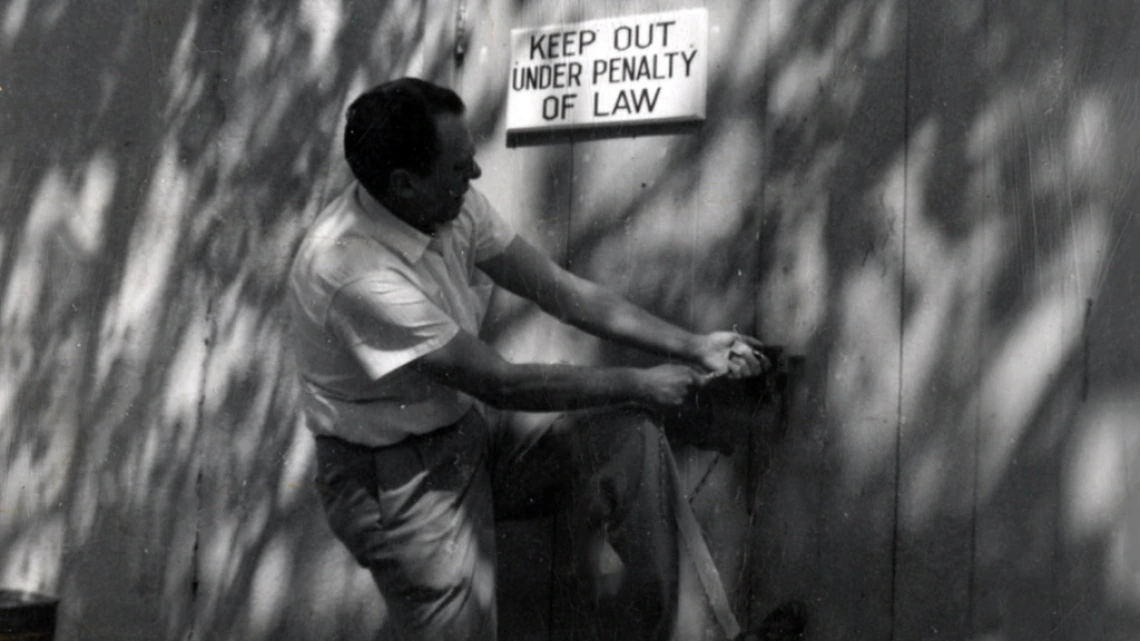Loujon Press collection

Photograph of Charles Bukowski, 1962.
Collection area: Literature
Collection dates: 1961-2013
This collection provides insights chiefly into writer Charles Bukowski's daily life in Los Angeles, California from late 1962 to summer 1965. The correspondence, over two hundred letters from him to Webb, are filled with prime Bukowski narration of hard drinking, bad luck at the horse races, neurotic neighbors, demanding landlords, reflections on writing and other poets, his daytime jobs, his enthusiasm for the efforts of Jon and "Gypsy" Louise Webb and their Loujon Press, and a myriad of other topics. Some letters are written or appended with notes from Frances Bukowski about the current state of things in their lives as they lived on North Mariposa Avenue and later De Longpre, including the birth and infancy of their daughter, Marina Louise. Bukowski's satisfaction with the wonder of It Catches My Heart in Its Hands is candidly portrayed in his letter of November 26, 1963.
By 1964, Bukowski begins to draw, paste, and color the marginalia of the letters and envelopes. Collages of bubble-gum cartoons and cigar bands are pasted on ink, water-colors and scraps of paper while his messages scroll around and between the drawings. The typewritten letters are no more, Bukowski is headed for the big time, and the Webbs and Loujon Press have provided him with two marvelous books as passport portfolios.
Additional letters are from John William Corrington to Webb, and from Webb to Bukowski. There are also a large file of letters of praise for It Catches My Heart in Its Hands from admirers including Lawrence Ferlinghetti, Kenneth Patchen, Henry Miller, and Walter Lowenfels.
A notebook by Bukowski contains 58 pages of handwritten, mostly unpublished poems, and includes a three page commentary on the contemporary state of poetry titled, "A depressing state of affairs...."
The photographs in the collection contain ten of Bukowski, one of his dog, three of the Webbs in their apartment/studio at 1109 Royal, New Orleans, and three of the Tucson residence at 1009 E. Elm as it appeared in 1997. There is also color and ink drawings by Bukowski, including five self-portraits. Some of the photographs and drawings were done for possible inclusion in the poetry books.
The manuscript files relating to the two books contain handwritten and typewritten poems by Bukowski (some with corrections), production materials, galleys, dummys, tearsheets from other poetry books of his poems, and related materials, such as biographical and exhibition materials relating to Noel Rockmore who created etchings for Crucifix in a Deathhand.
The final three series consist of correspondence between Louise and Jon Webb and their friend Mike Newman, Jon Webb to Louise, and between Mike Newman and Jon Webb Jr. It also consists of audio recordings of an interview series with Louise Webb and Mike Newman on 14 audio cassettes with access copies on 27 audio CDs, printed materials, and miscellaneous artwork and materials relating to the administration of the press.
After working as free-lance editors in New York City, Jon and Gypsy Lou Webb moved to New Orleans. There they produced an avant-garde poetry and prose magazine, The Outsider (1961-), for American "underground" writers. Pouring all their money and energy into their letterpress Loujon Press, they designed and produced several limited editions of works by Charles Bukowski and Henry Miller from 1963 until 1966. In 1965, the Webbs moved to Santa Fe, El Paso, and settled for a while at 1009 E. Elm in Tucson. They later moved the press to 1202 Fourth S.W. in Albuquerque. Jon Webb died in Nashville on June 9, 1971. His obituaries are cited in AB Bookman's Weekly, August 2, 1971.
A collection guide explains what's in a collection. New to using our collections? Learn how to use a collection guide.
Collection guideAccess this collection
Visit us in person to access materials from this collection. Our materials are one-of-a-kind and require special care, so they can’t be checked out or taken home.
How to cite
Learn how to cite and use materials from Special Collections in your research.
